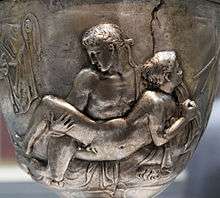Catamite
Not to be confused with Calamite.

Warren Cup, depicting sexual intimacy between an "erastes" (a young man) or a "pederast" and his "eromenos" (his beloved boy) or "catamite"

Roman Ganymede as a puer delicatus, with the eagle of Jove
In its modern usage the term catamite refers to a boy as the passive or receiving partner in anal intercourse with a man.[1]
In its ancient usage a catamite (Latin catamitus) was a pubescent boy who was the intimate companion of a young man in ancient Greece and Rome, usually in a pederastic relationship.[2] It was usually a term of affection and literally means "Ganymede" in Latin. It was also used as a term of insult when directed toward a grown man.[3] The word derives from the proper noun Catamitus, the Latinized form of Ganymede, the beautiful Trojan youth abducted by Zeus to be his companion and cupbearer.[4] The Etruscan form of the name was Catmite, from an alternate Greek form of the name, Gadymedes.[5]
References in literature
- In Plato's dialogue Gorgias (at 494d) Socrates uses the term in a conversation with Callicles contrasting appetites and contentment.
- The word appears widely but not necessarily frequently in the Latin literature of antiquity, from Plautus to Ausonius. It is sometimes a synonym for puer delicatus, "delicate boy". Cicero uses the term as an insult.[3] The word became a general term for a boy groomed for sexual purposes. Also appears in Meditations by Marcus Aurelius.
- Stephen Dedalus ponders the word in Ulysses when discussing accusations that William Shakespeare might have been a pederast.
- C. S. Lewis in his partial autobiography Surprised by Joy described the social roles during his time at Wyvern College (by which he meant Malvern College) as including the role of "Tart": "a pretty and effeminate-looking small boy who acts as a catamite to one or more of his seniors..." and noted that "pederasty...was not [frowned upon as seriously as] wearing one's coat unbuttoned." [6]
- Anthony Burgess's 1980 novel Earthly Powers uses the word in its "outrageously provocative"[7] opening sentence: "It was the afternoon of my eighty-first birthday, and I was in bed with my catamite when Ali announced that the archbishop had come to see me."
- In the postapocalyptic landscape of Cormac McCarthy's novel The Road, the narrator describes an army on the move on foot with "women, perhaps a dozen in number, some of them pregnant, and lastly a supplementary consort of catamites." [8]
- In this first letter to the Corinthians (1 Corinthians 6:9-10), Paul admonishes "You know perfectly well that people who do wrong will not inherit the kingdom of God: people of immoral lives, idolaters, adulterers, catamites, sodomites, thieves, usurers, drunkards, slanderers and swindlers will never inherit the kingdom of God.[9]
See also
References
- ↑ Oxford English Dictionary 3rd Ed. (2003)
- ↑ Craig Williams, Roman Homosexuality (Oxford University Press, 1999, 2010), pp. 52–55, 75.
- 1 2 Cicero, frg. B29 of his orations and Philippics 2.77; Bertocchi and Maraldi, "Menaechmus quidam," p. 95.
- ↑ Alastair J.L. Blanshard, "Greek Love," in Sex: Vice and Love from Antiquity to Modernity (Wiley-Blackwell, 2010), p. 131. Both Servius, note to Aeneid 1.128, and Festus state clearly that Catamitus was the Latin equivalent of Ganymedes; Festus says he was the concubinus of Jove. Alessandra Bertocchi and Mirka Maraldi, "Menaechmus quidam: Indefinites and Proper Nouns in Classical and Late Latin," in Latin vulgaire–Latin tardif. Actes du VIIème Colloque international sur le latin vulgaire et tardif. Séville, 2–6 septembre 2003 (University of Seville, 2006), p. 95, note 16.
- ↑ Larissa Bonfante and Judith Swaddling, Etruscan Myths (University of Texas Press, 2006), p. 73.
- ↑ Surprised by Joy: The Shape of My Early Life, Chapter VI Bloodery, pp.83-84, C. S. Lewis
- ↑ "An arresting opening". Telegraph. Retrieved August 30, 2012.
- ↑ McCarthy, Cormac (2006). The Road. Vintage International. p. 92. ISBN 9780307387899.
- ↑ Wansbrough, Henry (1985). The New Jerusalem Bible. New York; London: Doubleday; Darton, Longman & Todd. pp. 1 Corinthians 6:9–10. ISBN 0385142641.
External links
-
 The dictionary definition of catamite at Wiktionary
The dictionary definition of catamite at Wiktionary
This article is issued from Wikipedia - version of the 9/6/2016. The text is available under the Creative Commons Attribution/Share Alike but additional terms may apply for the media files.